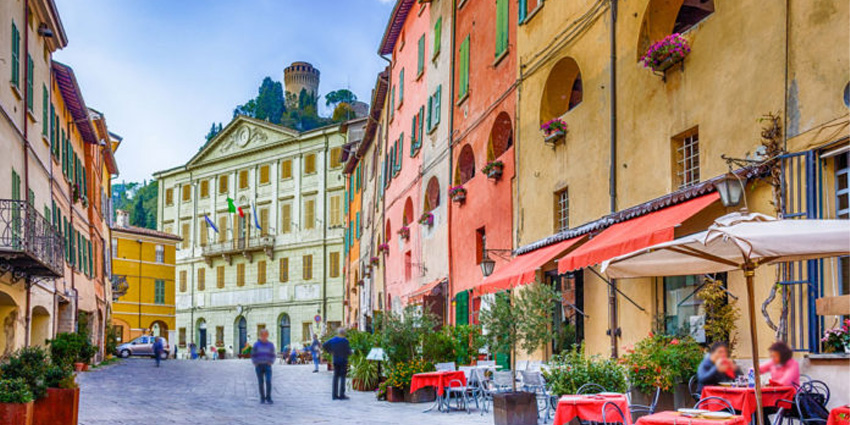
Brisighella: the village of three hills, gypsum, history, and Emilian-Romagnol hospitality
Nestled among the rolling hills of the Apennines, halfway between Ravenna and Florence, lies Brisighella,
one of the most charming medieval villages in Italy. From afar, its unmistakable silhouette emerges: three hills crowned by three symbolic monuments – the Rocca Manfrediana, the Clock Tower, and the Sanctuary of Monticino – standing guard over the village for centuries, preserving its stories in silence.
Gypsum, the soul of the village
The true protagonist of Brisighella is gypsum, a rock that has shaped the surrounding landscape. The hills on which the village rests, the pale-colored houses, the stairways carved into stone, and even the street names speak of this natural resource. Gypsum has influenced not only the architecture but also the daily lives of its inhabitants.
One of the most iconic examples is the Via degli Asini (“Donkeys’ Road”), an ancient elevated and covered street characterized by irregular arches. Once used by cart drivers transporting gypsum, today it offers visitors a journey back in time, with glimpses that seem suspended between history and legend.
A historic center to explore step by step
Brisighella’s historic center is a maze of cobbled alleyways, small squares, and pastel-colored buildings. Every corner holds details that tell centuries of community life: flowered balconies, wrought-iron signs, shaded courtyards. The main square, with its arcades and cafés, is the beating heart of local life – a place where time appears to move more slowly.
Wandering through the village reveals ever-changing perspectives: at every turn, new views open onto the Lamone Valley, the gullies, and the gentle profiles of the Apennines. The shifting light enhances the warm tones of the façades and the brightness of the gypsum stone.
A tradition of hospitality and local flavors
Brisighella is renowned for its authentic hospitality. Here, welcoming guests is not just a concept but a deeply rooted part of the local culture. Over the centuries, pilgrims, travelers, and merchants have found rest within its walls, creating a tradition that remains alive today.
Local gastronomy is a story of its own: the celebrated Brisighello DOP extra virgin olive oil, fresh and aged cheeses, aromatic herbs gathered from the hills, and wines from the Romagna vineyards all express a profound connection with the land. Brisighellese cuisine follows the rhythm of the seasons, offering dishes that combine simplicity and flavor – from wood-fired bread to handmade pasta.
A village alive in every season
Although Brisighella’s charm is timeless, spring and autumn are the ideal moments to experience it fully. In spring, the hills turn vibrant green, and the trails invite scenic walks. In autumn, warm colors embrace the village, while fairs and festivals celebrate the fruits of the land.
The surrounding area offers nature trails ranging from routes through the UNESCO-listed gypsum quarries to paths leading into the Tuscan-Romagnol Apennines. Each route provides a different perspective of the village and the landscape, with views worthy of a postcard.
A heritage of history and nature
Beyond its architectural beauty, Brisighella holds a historical and environmental heritage of great value. The 14th-century Rocca Manfrediana tells stories of medieval lords and battles. The Clock Tower, perched in a panoramic position, offers unmatched views of the valley. The Sanctuary of Monticino has welcomed travelers and pilgrims for centuries, overlooking a landscape that seems unchanged by time.




